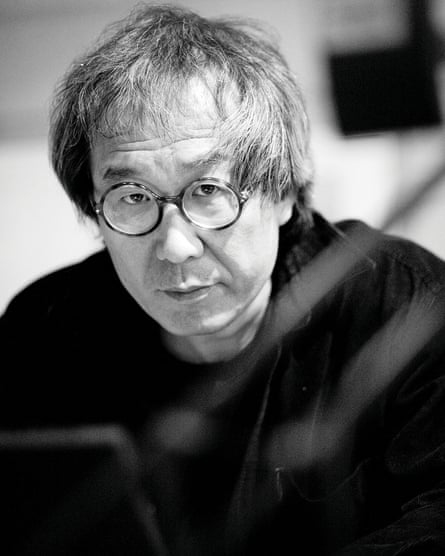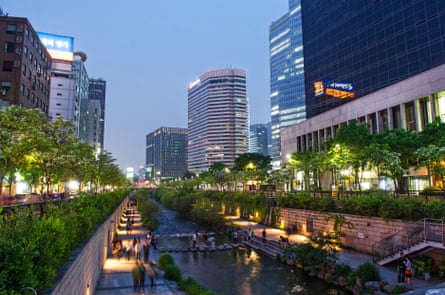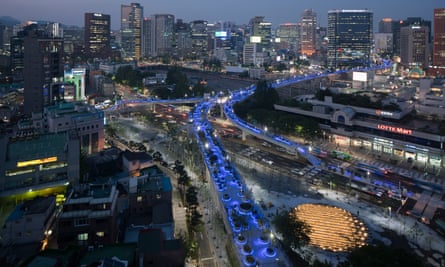Stop me if you’ve heard this before. The ambitious mayor of a big city backs a project to put a garden on a bridge. A celebrated designer is appointed and seductive images released. It gets compared to the High Line in New York – that urban phenomenon envied as much by rival cities as the Eiffel Tower once was. It provokes controversy.
This much the Skygarden in Seoul has in common with the Garden Bridge in London, but then their stories diverge. Where the London version has foundered, the Korean one will be opened this Saturday by mayor Park Won-soon, a former activist who built his career on opposing both corruption and the conservative establishment, and supporting human rights.
Given the recent turmoil in South Korean politics, in which the former president has been deposed, imprisoned and is awaiting trial on corruption charges, the Skygarden will likely to be a symbol of the alternatives offered by the new president Moon Jae-in, and his ally mayor Park.
There are significant differences in the conception and execution of the two projects. They vary in cost (about £40m for the Skygarden and £200m-plus for the Garden Bridge) and, where the London project has spent many years not happening, the Seoul one has taken two years to take shape since its Dutch architects, MVRDV, were appointed in 2015.
Where the Garden Bridge would have been a cherry on the already rich cake that is the centre of London, the Skygarden aims to regenerate and connect places near the main railway station that have been fragmented by roads and railway tracks. The Skygarden, which will be open to all 24 hours a day, re-uses an existing structure – like the High Line – in the form of a 1970 motorway flyover that was no longer deemed safe for its original purpose.
It is also part of a bigger set of ideas about taking a big, dense – sometimes ugly – city, one which was created without a great deal of concern for public space and pedestrian movement, and giving it qualities of walkability, neighbourliness, human scale and shared enjoyment of its places. To this end, the mayor has encouraged a range of public works and created the post of city architect to help make them happen.
The Skygarden is one of the more eye-catching examples of several initiatives promoted by the first holder of this job, Seung H-Sang, and his successor and ally Young Joon Kim.

Seoul resembles other cities of east Asia such as Tokyo and Shanghai in its scale and rapid postwar expansion, while major western cities such as New York and London also experience comparable pressures of growth. If Seoul gets its programme right, it can set examples for other megacities to learn from. An inaugural Biennale of Architecture and Urbanism will be held this autumn to help get the message across.
South Korea’s capital is an ancient city, with a beautiful natural backdrop of mountains, that was devastated in the 20th century by Japanese occupation and the Korean War. It was reconstructed on American-inspired lines, with multilane highways criss-crossing the city. Economic and population growth – it has about 10 million people compared with 1 million in 1950, although the increase has now levelled off – caused the spaces between to be filled in at levels of density that are nearly twice New York’s.
It is a business-minded city, its desire for prosperity being sharpened by the traumas and poverty of its recent history, and the need to erect office blocks to serve its economy has usually taken precedence over architectural and urban finesse. The lower levels of buildings tend to be intensely colonised by commercial activity.
At the same time, portions of historic fabric remain – such as the gardens of shrines and palaces and areas of hanoks, traditional houses often built around courtyards. In the crevices and spare spaces of what is a patchwork city, and one whose general shape was not precisely intended by anyone, the current generation of lively and enterprising Korean architects have inserted distinctive individual works. What it hasn’t had so much are the sort of interventions in public spaces that a European city like Barcelona has been implementing since the 1980s, or which New York has been pursuing for most of this century.
Seoul’s fabric partly reflects the distribution of power in South Korea, where huge conglomerates, or chaebols, tend to take precedence over government. Institutions that in other countries might be provided by the state – art galleries, libraries – are often created by the likes of Samsung and Hyundai. This phenomenon can create some useful and fine buildings, but they often come with strings attached. A vinyl record library, for example, which is a good-looking building paid for by Hyundai Card, comes with special privileges and incentives for card holders. Another shiny and elegant building, which looks like a contemporary art museum, turns out to be a somewhat preposterous shrine to the Hyundai credit card, where you can see the precious objects being made and exhibits on their history.
The mayor’s works programme aims to redress the balance. His successive chief architects have aimed to make the city more pedestrian-friendly and where possible to adapt the existing fabric rather than erase it in favour of grand new structures. “Revitalisation” rather than “reconstruction” is how Seung H-sang puts it. The city government is also considering the introduction of a congestion charge for the historic centre of the city.

Other projects have included the renovation of Seunsangga (currently under way), a 1km-long 1960s shopping megastructure that became a centre of electronics businesses, built on land that had been cleared as a wartime firebreak. Most cities would have seen at as an eyesore, worn out and in need of total replacement, but Seung recognised that it was now part of the life and tissue of the city. The aim now is to encourage businesses of the fourth industrial revolution – robotics, 3D printing and so on – to move there.
Seung also launched what he calls “the most important project in Seoul”, which is the conversion of 424 redundant local administrative offices into neighbourhood uses such as libraries, small theatres, concert halls and cafes. The budgets are small, requiring maximum invention from the usually young architects hired to work on them.
The Skygarden – or Seoul-lo 7017 as it is also called in reference to the dates of the original structure, and of its reincarnation – is both a symbol and an instrument of the shift from car to foot. The original concrete structure has been strengthened, and lifts, stairs and escalators have been added where necessary to connect it to the ground. Bridges also connect to adjoining commercial buildings, who have to pay for the uplift in value. Other uses – cafes, performance spaces, a market – are scattered across the site.

The old bridge and its surroundings are then brought to life by what Winy Maas of MVRDV calls a “library” of 24,000 plants, all indigenous species arranged according to the Korean alphabet. The types of plant then prompt arrangements and uses: pines suggest a forest, and jasmine “has a very obvious relationship to tea gardens”. Ginkos are “hyper bisexual” and arranged in a way that somehow reflects their orientation. Roses “turn out to be very theatrical”, so a theatre is placed among them. When the plants get too big they can be sold and replaced – and Maas says that in this way the library is also a “nursery”.
The hard engineering, which he calls “brutal but also nice” is kept grey and neutral “in order to celebrate the richness of the plants”. “Fog machines” and shade will keep people cool in the hot summers.
Maas says that the garden will be “human and friendly and green” in ways that might be thought typical of European city planning, but will also have a “science fiction element” that he sees as more Asian. “In Asia they want to dip their cities in this super-green feeling that comes from science fiction, from movies like Avatar,” he says, citing Singapore’s spectacular Gardens by the Bay. His designs bring out the intense colour contrasts of different species, and the Skygarden will be bathed at night in a rich, artificial blue light. It doesn’t look – and it doesn’t want to be – perfectly natural.
Young Joon Kim, the current city architect who also worked as the coordinator of the Skygarden project, says that he is “very happy”. He acknowledges that not everyone is pleased about handing over road infrastructure to pedestrians – drivers of cars and commercial vehicles, for example – but says that “when you look at things over a longer period it’s clear that citizens have to have car-free zones. It’s not a kind of taste, it’s the way to go, like many other cities.” He acknowledges that some people think that the garden is “too artificial”, but “you cannot copy the natural landscape”, he says.
Young Joon Kim is also delighted with the change of president, not least because national government controls adjoining property such as the railway station and the last administration had been awkward about collaborating.
Minsuk Cho, a Seoul architect, agrees: “It’s all great here since the new president Moon and mayor Park have been very close allies, what the mayor has been doing despite of the previous oppositional government will, from now on, will get so much more support.”
Mayor Park didn’t introduce the idea of public urban interventions – one of his predecessors restored the Cheonggyecheon waterway that had been covered by a highway and another commissioned the bombastic Dongdaemun Design Plaza, designed by Zaha Hadid architects.
What differentiates the Skygarden and its allied projects is their ambition to grow out of the character and needs of contemporary Seoul. For similar reasons the Skygarden promises to be among the more convincing of all the many High Line wannabes in the world. Whether or not MVRDV’s designs prove to be too “artificial” huge crowds can be expected, along with global fame. It could be a garden bridge that works.
Follow Guardian Cities on Twitter and Facebook to join the discussion, and explore our archive here

Comments (…)
Sign in or create your Guardian account to join the discussion